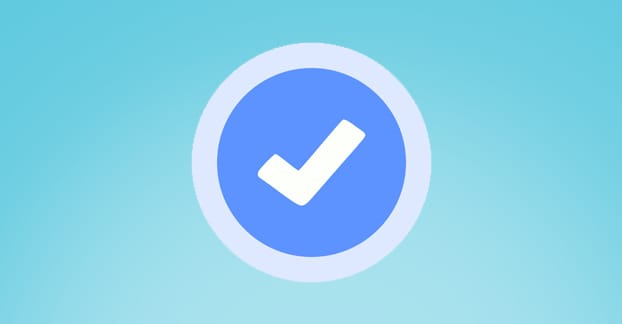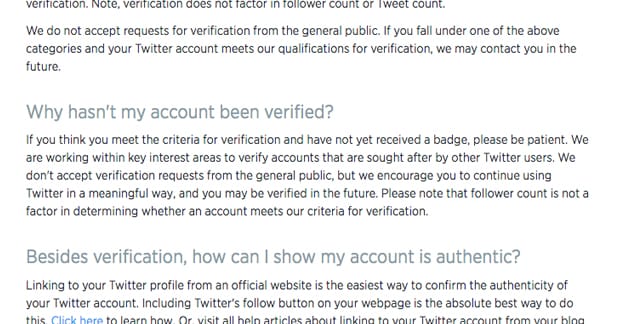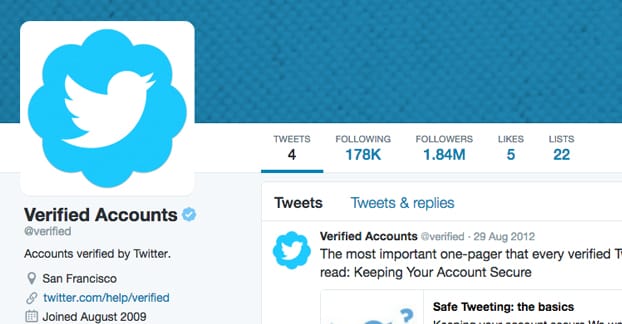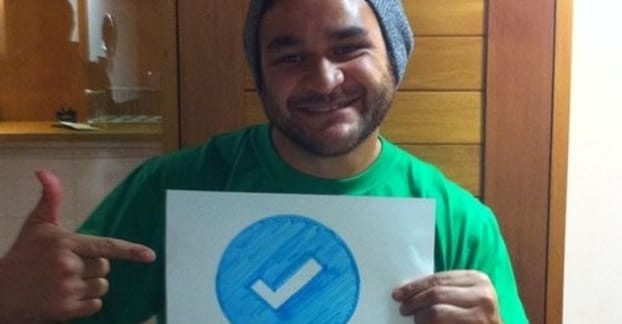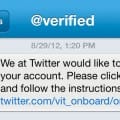Twitter verification is something of a controversial subject among certain subsets of people using the site. Some people don’t care one way or another about verification, and the majority of users pay attention to it only when an imposter account becomes an issue. Occasionally, you have a big stink, like when the intentionally offensive and unfunny microblogger Milo Yiannopoulos had his removed. You have legions of people tweeting at and following @Verified in hopes that socializing with the bot will get them closer to verification. That account hasn’t posted or responded to anyone in four years, but that won’t stop people from trying.
Then you have the value argument. On one side you have the people who believe verification is a great boon on any account, the people who strive to earn it and the people who advise their clients to aim for it. I’m guilty of that myself. On the other hand, you have people who decry the entire thing as meaningless, a participation trophy for famous people.
I think there’s real value in verification, but that value comes solely from the perception that there is value in verification. On its own, in a vacuum, verification doesn’t really do anything for you. It shows users you are who you say you are, but was there ever any question of that? Only if there’s someone else trying to impersonate you. It doesn’t open up any new functions of the site. It doesn’t give you cheaper ads. It doesn’t suddenly make you more powerful in some way.
The sole value of verification comes from how the people in your audience feel that verification makes you special. It’s a mark of authority from on high, it’s a sign that Twitter recognizes you for who you are and gives you some assignment of worth. That perception – even though it’s undermined by many of the low-tier accounts that have been verified – is what gives your verification weight.
No matter how based in perception verification may be, it’s tangible in certain circles. A writer for The Atlantic talks about a time when he was blown off by a prominent figure at a silicon valley networking event, but the guy changed his tune when he saw the verification. The big-wig had over 100,000 followers but no verification, whereas the writer had 5,400 and the check. That covetous greed immediately triggered the “I can use this” flag in the 100K guy, immediately making him more affable and more willing to chat.
And wouldn’t you be, if you knew you could get something out of it? That’s the problem, though; it takes more than just networking with a verified user to get verification yourself. A lot more, potentially.
All Aboard the Verification Train
So how does someone go about getting verified? Is there a defined process? Are there some esoteric requirements that need to be met before you can get it? Is there a form to fill out?
Well, the answer to this depends on who you ask, and there are a lot of theories thrown around.
From Twitter, the official answer is simple. You don’t go out in search of verification; verification finds you. They focus on users who happen to be in a set of specific industries, primarily music, acting, fashion, public officials, political figures, religious figures, journalists, media producers, sports folks, and businesses.
If that sounds like a broad list of categories, you’re right, it is. It’s a pretty big list, and it can be twisted to cover just about anyone, from YouTube musicians to billion-dollar actors.
More important is the line “Note, verification does not factor in follower count or Tweet count.” Twitter is upfront about telling everyone that it doesn’t matter how often they tweet, now many times they’ve tweeted, or how many people follow them.
Except, of course, we all know this is a lie. You can’t get verification if you aren’t tweeting; you’re not using the site, so why should they verify you? You can’t get verification if you have less than a couple thousand followers, generally. You certainly can’t get verification if you have a history of any sort of abusive behavior, like artificially boosting your follower count with fake bots. Twitter also won’t verify you – and may remove verification if you have it – if you’re abusive or break Twitter’s rules.
Speaking of things that will remove verification, you’re locked into your @username when you’re verified. You can change it, but you’ll lose verification and will have to go through the process of getting it back if you do. There’s no way to fast track the process, either, so you’ll just have to send a support ticket and hope.
Now, there’s a public perception that you can get verified with enough persistence, or that there’s some secret method to it. I’ve seen all sorts of different ideas.
- If you send a message to @verified, you’ll be put on a shortlist for verification and will be considered for it next time they do a review.
- If your account is being impersonated and enough people report the impersonator, you can be verified to prevent it from happening in the future.
- If enough of your audience tweets at people in charge, or gets a #verifyusername hashtag trending, you can get verified on the weight of public pressure.
- If you send a message to one of the Twitter employees in charge of verification, you’ll be able to get them to verify you directly.
- If you spend a lot of money on ads through Twitter, you can get verified because they want to keep you around.
- If you’re personal friends with someone high up at Twitter, you can get verified as a personal favor, even if you’re not typically in an industry considered for verification or you’re not personally considered notable.
- If you’re part of an organization, that organization may be able to strike a deal with Twitter to get key employees verified as a fringe benefit.
Now, as far as I know, the first one is just a waste of time. Sending a message or tweeting at @Verified is pretty unlikely to do anything more than just add +1 to the spam that whoever runs the account ignores or deletes on a regular basis.
The second one might work, but it’s not really something you can control. Oh, I suppose if you wanted you could use a proxy and a bunch of fake account information, not to mention a lot of time and effort, to impersonate yourself. You’d have to spend a lot of effort building the presence of the imposter account, though, and you might as well spend all that time and energy building your own audience so you’re more available for verification naturally.
The third one doesn’t really work either. If your audience is too small to get a minor hashtag trending, you’re not going to reach the sort of critical mass that can gain Twitter’s attention. If, conversely, you’re large enough to get that kind of trend going, you’re probably already in the process of being verified, Twitter just hasn’t sent you the link yet.
The fourth one seems to me to not really be effective. There’s no one public employee in charge of verification. If there were, you can bet they would be avoiding as much spam as possible, and you can bet that messaging them repeatedly about getting yourself verified isn’t going to help you out.
The fifth one, well, I’ll discuss that in a moment. The sixth, though, is definitely a functional method, though it’s not always a viable method. If you happen to be friends with someone like Biz Stone, sure, you can get verified pretty easily. It’s not like Twitter is really going to say no to their co-founder.
The seventh one is definitely real as well. It happened most notably and publicly with Buzzfeed. In a deal with Twitter, Buzzfeed got verification for most of its high level employees, particularly their public writers. Some declined it, but many accepted, and remain verified today even if they’ve left the company.
There are other methods people have tried as well. One of the strangest I’ve seen is to draw a verification symbol and take a selfie holding it, then make that your profile picture. I don’t see why that would influence anyone’s decision, but hey, some people will try anything.
Matters of Spending Money and Verification
I said I’d talk more about this one, and I will. One of the most persistent and ugly rumors is that the easiest way to get verification is to spend a lot of money on ads. The biggest problem with the rumor is that it’s not necessarily even a rumor. Money is power, and spending money means Twitter wants to keep you around. The more money you spend, the more valuable you are, and the more likely you are to get perks for spending.
The number one way buying ads can lead to verification is through a dedicated account manager. When you spend enough, Twitter assigns a staff member to you, to be available and helpful whenever you might have an issue. They can offer advice, troubleshoot ads, and work with you to lower costs and improve results. This is, of course, a good investment for Twitter; the better you do and the more you succeed on the site, the more you’re willing to spend and the more they’ll make.
The problem, of course, is that a dedicated account manager isn’t chump change. You’re not going to get one with a couple hundred bucks a week on ad spend. If you’re in a position to be worrying about where every dollar in your PPC campaigns is spent, you’re not a high roller enough to get the perks. The public threshold is $5,000 per month. Only if you can meet or exceed that on an ongoing basis can you get an account manager.
Account managers aren’t going to be able to verify you either. They don’t have that power; they just work with ads and marketing. Twitter says they can “escalate” a verification claim, but that’s it; you still have to impress the user verification team, and money alone won’t do it.
The True Path to Verification
The truth is, other than having connections within Twitter itself – not trying to make them on the fly, but actually having them – there’s no sure-fire way to get yourself verified. It’s more of a side-effect of the other traits you possess.
If you want to get verification on Twitter, you’re going to have to actively use the site. You’re probably going to want to run ads, though you don’t need to go all-in with thousands a month unless you really have the budget to do so, and you really know you’re going to get a significant return on your investment. If neither is the case, don’t bother.
Your main focus, however, should be on growing your brand. People seeking verification directly tend to have a backwards perspective. They feel they’re worthy and that if they’re only given the chance, they can prove it and that Twitter will verify them. The reality is, they probably aren’t worth verification as they are. Instead of spending that effort trying to prove worthiness, spend the effort growing your brand such that you reach a point of value that Twitter can no longer ignore.
In other words, don’t worry about verification. It’s probably not important enough to agonize over. If you happen to make a connection to get it, good for you. Otherwise, just focus on using Twitter as a marketing tool and focus on growing your business. Sooner or later, you’ll reach the point where you’re significant enough for Twitter to take note, and they’ll offer you verification without having to jump through all of the hoops to prove you’re worth it.
